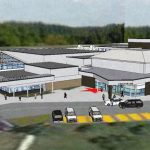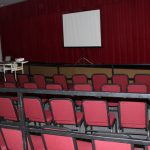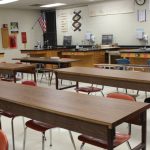Funds would support W-F improvements
By Angie Landsverk
The Weyauwega-Fremont School District is ready to take its $21 million referendum to its voters.
The district’s administrators and school board members spent the past few months attending town board meetings and other meetings of municipalities and civic groups to present information about the referendum question.
On last Thursday, Oct. 13, the second of two informational meetings took place.
Approximately 20 people attended it.
Voters in the school district are being asked on Nov. 8 if they want the district to spend up to $21 million on a building and improvement program.
The referendum includes a $339,432 project at Fremont Elementary and $20.6 million in improvements and additions at W-F High School.
“It’s the culmination of a lot of hard work,” District Adminstrator Scott Bleck said during the Oct. 13 informational meeting.
He said the process began in 2013 with strategic planning.
A study of the facilities, an educational analysis and community engagement then took place during 2014 and 2015.
Among the priorities then identified for the district were HVAC and efficiencies updates, secure entrances and improvements to the high school, which was built in 1969.
Debt free since 2010, the district’s current mill rate of $8.32 compares to the state average of $10.25.
Brian Brewer, of Robert W. Baird & Co., said the school district has one of the lowest tax rates in the state.
The district’s property value grew just shy of 3 percent this year, he said.
Brewer told those attending the Oct. 13 meeting that the bond market is near a 50-year low for interest rates.
That means school districts, which approved referendums late last year or early this year, are able to apply more toward principal payments, he said.
The current interest rate for 20-year financing is 2.85 percent, Brewer said.
“I’ve been doing this close to 20 years, and I’ve never seen it that low,” he said.
The W-F School District has been using an interest rate of 3.85 percent in its planning.
Brewer said the difference between the rate the district has been using and what the rate currently is equates to about $2.6 million less in interest costs.
Drew Niehans, the district’s business manager, said with the current projections, the district would not go above the state average any of the years during the proposed 20-year financing.
“With the current bond market, we may not even approach it,” he said.
The school district is proposing a 2016-17 mill rate of $7.69.
The district’s annual meeting to present the budget is scheduled to begin at approximately 7 p.m. on Monday, Oct. 24.
Brewer said the average mill rate impact of $2.65 per $1,000 of valuation could come in lower, which would help minimize the impact of paying the $21 million over the 20-year period.
That average mill rate impact of $2.65 would equate to an average annual tax impact of $198 for the owner of a $75,000 home, $265 for the owner of a $100,000 home and $398 for the owner of a $150,000 home in the district.
Bleck said the district presented a similar concept in 1998.
The cost then was $11 million, and many of the items that were part of that proposal are being addressed now in the $21 million referendum question, he said.
High school
The proposed improvements for W-F High School include the addition of four new classrooms on the back of the school for science, agriscience and the new Project Lead the Way curriculum. A new greenhouse would be constructed there as well.
The school’s current three science classrooms would be remodeled. Two would become math classrooms, and the other would become additional space for the art classroom.
A 400-seat auditorium would be built in front of the high school.
“It would give students who perform in the fine arts a rightful place to perform,” Bleck said.
The current auditorium seats 200 people. It does not have air conditioning.
The proposed auditorium would be a stand-alone facility, attached to the high school and available for use by students and the community.
The vocal room, which is currently in the middle school, would be brought back to the high school and be located near the band room and auditorium.
A multipurpose gym would be built off the present gym area and be meant to eventually replace the gym in the district’s old middle school building on Main Street.
In the current high school gym, the bleachers – original to the building – would be replaced.
The proposal also includes a new secure entry to the high school, a remodeled commons, flexible learning areas and a remodeled forum room for students or community gatherings of 125 people.
The remodeling of the high school would bring more natural light into the classrooms.
The high school locker rooms would also be remodeled, and there would also be a new workout area.
Bleck said it would be a goal to have the workout area be a resource for the community.
The auditorium and multipurpose gym would be as well.
The high school would also see HVAC improvements.
The six boilers in the high school are approaching 30 years old.
One of them is currently down, with more than 26,000 hours of service on it, Bleck said.
Dean Beeninga is an architect and educational facility planner at ATS&R, the Minneapolis-based firm hired by the district.
“Your school was built in 1969. Your community leaders did a good job,” he said. “We’re trying to give students different spaces for different opportunities to learn.”
Fremont Elementary
At Fremont Elementary, an addition is being proposed along James Street.
It would move the reception area and principal’s office from the interior of the building to there.
As the main entry to the school, it would also include a lobby and conference room.
After the vote
If the Nov. 8 referendum is successful, a six to eight-month design process is anticipated for the project.
That would be followed by seeking bids for the work, and Bleck reminded those attending last week’s meeting that W-F’s referendum is not the only one on the docket statewide.
Beeninga said it would take between 2 to 2 1/2 years to complete the project.
It would take place in phases.
This year there are 841 students in the school district.
In the late 1990s, the district’s enrollment peaked at about 1,200, Bleck said.
Since then, there has been a general decline, with the district in the 850 to 860 mark the last five years, he said.
He believes the district’s enrollment would continue to trend around 850, and he said questions are why the district wants to add on are valid points.
“Whether we have 850, 550 or are back up to 1,200, we have a responsibility to provide a facility for learning,” Bleck said. “If we were to see a spike, as a community, we should feel comfortable that we could accommodate that.”



